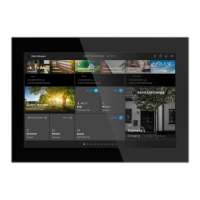
Do you have a question about the ABB SmartTouch i-bus KNX and is the answer not in the manual?
| Display Type | TFT LCD |
|---|---|
| Resolution | 480 x 272 pixels |
| Touch Technology | Capacitive |
| Power Supply | KNX bus |
| Protection Class | IP20 |
| Ambient Temperature | 0 °C to +45 °C |
| Operating System | Linux |
| Operating Voltage | 24 V DC |
| Communication | KNX |
| Display Size | 4.3 inch |
| Mounting | Flush mounting |
Explains warning symbols and their meanings for hazards.
Defines the proper application and purpose of the device.
Lists prohibited uses and ABB's liability for damages.
Specifies qualifications and rules for installation personnel.
Discusses security measures for network and system access.
Provides critical safety warnings related to electrical voltage and external factors.
Advises on proper disposal of electronic waste and packaging materials.
Lists items included in the product package and required accessories.
Lists essential components not included in the standard scope of supply.
Presents a table detailing different product variants, article numbers, and colors.
Summarizes the device's capabilities and supported KNX functions.
Identifies components and connections on the front and rear of the device.
Provides detailed physical dimensions of the device and installation boxes.
Shows electrical connection diagrams and pin assignments for the device.
Guides on planning system integration with Welcome and free@home manuals.
Highlights risks of mixing low-voltage and mains voltage conduits in installation boxes.
Outlines necessary knowledge, safety rules, and tools for electrical installers.
Lists crucial steps before installation, like wiring practices and avoiding interference.
Provides guidelines on selecting locations and details mounting methods.
Explains device connection, address setting, and switch configuration.
Details power supply needs and provides visual instructions for device installation.
Explains the procedure for safely removing the device from its mounting.
Guides through the initial setup process specifically for ABB-free@home systems.
Lists prerequisites and guides for integrating the device into the KNX system via ETS.
Introduces the DCA software and its role in configuring KNX functions.
Explains the different sections and their functions within the DCA interface.
Defines key terms and structural elements of the panel interface.
Recommends a standard workflow for effective DCA commissioning.
Guides on setting fundamental panel configurations like language and dashboard naming.
Guides on structuring the panel's navigation by creating operating pages.
Details how to add and parameterize control elements on the operating pages.
Provides instructions for modifying existing control elements on operating pages.
Covers setting up and configuring various applications available on the panel.
Guides on selecting and editing communication objects for control elements via ETS.
Explains how to create and manage group addresses for functional allocation.
Introduces extra tools accessible via the DCA icon bar for project management.
Explains how to identify, allocate, and name connected devices within the system.
Covers general and specific parameter settings for each channel via the System Access Point.
Guides on manually configuring panel buttons and functions.
Details naming, size, switch type, object types, icons, and disable function.
Covers naming, function color, size, icon type, status, and object type.
Details naming, function color, size, icon type, and dimming methods.
Covers naming, function color, size, icon type, value display, and slider behavior.
Explains naming, function color, value display, and lamp type configuration.
Details naming, function color, size, control type, icon type, and status.
Covers naming, function color, additional functions, temperature input, and unit.
Details naming, function color, size, icon type, telegram repetition, and object type.
Covers naming, room, size, icon, temperature display, setpoints, and modes.
Details naming, function color, scene start, long operation, scene number, and save options.
Covers naming, function color, size, slider direction, value display, and slider behavior.
Details naming, function color, display types, object types, and measurement displays.
Covers naming, function color, number of sources, and playback control parameters.
Details naming, function color, size, and linking to other pages.
Explains PIN protection, ring tone, and speech volume presets for door communication.
Covers enabling messages, PIN protection, export, archiving, and signal tones.
Details message naming, type, alarm type, text, and acoustic alarm settings.
Explains scene actuator naming, participant count, scene numbering, and object types.
Covers enabling presence simulation, PIN protection, and export options.
Explains PIN protection for time programs and overwriting during download.
Details channel application types, logic gates, input/output objects, and multipliers.
Covers device functions, control functions, operating modes after reset, and temperature readings.
Lists objects for start page activation, system settings, date, time, and display brightness.
Details objects for bell volume, voice control, ringing, call status, and binary inputs.
Lists objects for signal tone volume, message confirmation, and alarm types.
Details objects for scene activation, dimming, and scene number control.
Lists objects for presence simulation activation and general object control.
Details objects for blocking time programs, logic gates, multiplexers, and comparators.
Lists objects for heating/cooling control, setpoints, and operating modes.
Explains the device's boot-up process and initial display after power connection.
Introduces various control elements like switches, dimmers, and sliders for basic functions.
Explains moving/deleting elements, changing background images, and dashboard customization.
Details using door communication features like video surveillance and call functions.
Covers presence simulation, fault/alarm messages, and time programs.
Covers device adjustments for display, sound, network, access, and software updates.
Guides on transferring configuration files to the micro SD card and the device.
Explains assigning addresses using trimmers and DIP switches for networked devices.
Provides instructions on how to safely clean the device, avoiding damage.